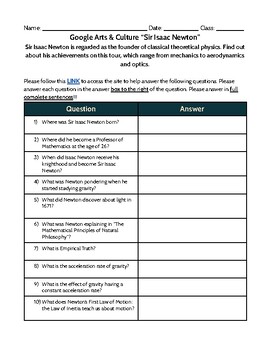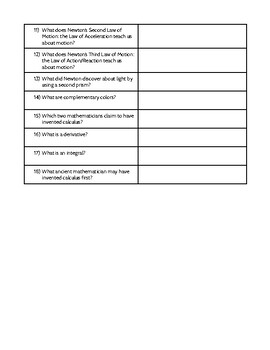Google Arts & Culture “Sir Isaac Newton” PDF
Mrs Glitterski Classroom
7 Followers
Resource Type
Standards
NGSSMS-PS2-4
NGSSMS-PS2-2
NGSSHS-PS2-1
NGSSMS-PS2-1
Formats Included
- PDF
- Internet Activities
Pages
2 pages
Mrs Glitterski Classroom
7 Followers
Compatible with Digital Devices
The Teacher-Author has indicated that this resource can be used for device-based learning.
Description
This worksheet will walk students through the article. The questions are in the order of the article.
Total Pages
2 pages
Answer Key
Not Included
Teaching Duration
1 hour
Report this resource to TPT
Reported resources will be reviewed by our team. Report this resource to let us know if this resource violates TPT’s content guidelines.
Standards
to see state-specific standards (only available in the US).
NGSSMS-PS2-4
Construct and present arguments using evidence to support the claim that gravitational interactions are attractive and depend on the masses of interacting objects. Examples of evidence for arguments could include data generated from simulations or digital tools; and charts displaying mass, strength of interaction, distance from the Sun, and orbital periods of objects within the solar system. Assessment does not include Newton’s Law of Gravitation or Kepler’s Laws.
NGSSMS-PS2-2
Plan an investigation to provide evidence that the change in an object’s motion depends on the sum of the forces on the object and the mass of the object. Emphasis is on balanced (Newton’s First Law) and unbalanced forces in a system, qualitative comparisons of forces, mass and changes in motion (Newton’s Second Law), frame of reference, and specification of units. Assessment is limited to forces and changes in motion in one-dimension in an inertial reference frame, and to change in one variable at a time. Assessment does not include the use of trigonometry.
NGSSHS-PS2-1
Analyze data to support the claim that Newton’s second law of motion describes the mathematical relationship among the net force on a macroscopic object, its mass, and its acceleration. Assessment is limited to one-dimensional motion and to macroscopic objects moving at non-relativistic speeds. Examples of data could include tables or graphs of position or velocity as a function of time for objects subject to a net unbalanced force, such as a falling object, an object sliding down a ramp, or a moving object being pulled by a constant force.
NGSSMS-PS2-1
Apply Newton’s Third Law to design a solution to a problem involving the motion of two colliding objects. Examples of practical problems could include the impact of collisions between two cars, between a car and stationary objects, and between a meteor and a space vehicle. Assessment is limited to vertical or horizontal interactions in one dimension.



